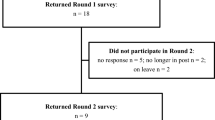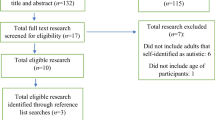Abstract
Neurofibromatosis type 1 (NF1) is a neurocutaneous genetic disorder that can be associated with severe complications, and it may shorten patients’ lifespan and affect their quality of life negatively. This study aimed to examine quality of life constructs among adults with NF1 in Brazil. It is an exploratory, descriptive and cross-sectional study consisting of two stages, involving thirteen adult patients with NF1. The first stage was developed using a quantitative methodology, namely the WHOQOL-100 questionnaire; responses for the 13 patients were compared to a matched control group. The second stage comprised clinical-qualitative research whereby participants took part in a semi-structured interview; these data were analyzed using the categorical thematic analysis technique. There were no statistically significant differences in the questionnaire domains between the NF1 patients and the control subjects. Eighteen main themes were extracted from the interviews, showing interference of the NF1 visibility principally in psychological aspects and social relationships. Patients mentioned curiosity about NF1 and confusion about the distinctions between NF1 and contagious diseases, which lead to prejudice. They were concerned about the future and how the disease would develop in themselves and their offspring, and emphasized difficulties acquiring proper healthcare. These findings may help in planning healthcare for Brazilian NF1 patients and improving their quality of life.
Similar content being viewed by others
References
Ablon, J. (1996). Gender response to neurofibromatosis 1. Social Science & Medicine, 42(1), 99–109.
Bardin, L. (2011). Análise de conteúdo (Vol. 70, p. 279). São Paulo: Edições.
Benjamin, C. M., Colley, A., Donnai, D., Kingston, H., Harris, R., & Kerzin-Storrar, L. (1993). Neurofibromatosis type 1 (NF1): knowledge, experience, and reproductive decisions of affected patients and families. Journal of Medical Genetics, 30(7), 567–74. doi:10.1136/jmg.30.7.567.
Campos, C. J., & Turato, E. R. (2009). Content analysis in studies using the clinical-qualitative method: application and perspectives. Revista Latino-Americana de Enfermagem, 17(2), 259–264. doi:10.1590/S0104-11692009000200019.
Cerello, A. C., Gianordoli-Nascimento, I. F., Moreira, A. H., Rocha, V. S., L.de Ribeiro, M., & de Rezende, N. A. (2013). Social representations of patients and relatives regarding Type 1 Neurofibromatosis. Ciência & Saúde Coletiva, 18(8), 2359–2368. doi:10.1590/S1413-81232013000800020.
Cohen, J. S., Levy, H. P., Sloan, J., Dariotis, J., & Biesecker, B. B. (2015). Depression among adults with neurofibromatosis type 1: prevalence and impact on quality of life. Clinical Genetics, 88(5), 425–430. doi:10.1111/cge.12551.
Crawford, H. A., Barton, B., Wilson, M. J., Berman, Y., McKelvey-Martin, V. J., Morrison, P. J., et al. (2015). The impact of neurofibromatosis type 1 on the health and wellbeing of Australian adults. Journal of Genetic Counseling. doi:10.1007/s10897-015-9829-5.
Fleck, M. P., Louzada, S., Xavier, M., Chachamovich, E., Vieira, G., Santos, L., et al. (1999). Application of the Portuguese version of the instrument for the assessment of quality of life of the World Health Organization (WHOQOL-100). Revista de Saúde Pública, 33(2), 198–205.
Fombuena, M., Galiana, L., Barreto, P., Oliver, A., Pascual, A., & Soto-Rubio, A. (2015). Spirituality in patients with advanced illness: the role of symptom control, resilience and social network. Journal of Health Psychology. doi:10.1177/1359105315586213.
Fontanella, B. J., Campos, C. J., & Turato, E. R. (2006). Data collection in clinical-qualitative research: use of non-directed interviews with open-ended questions by health professionals. Revista Latino-Americana de Enfermagem, 14(5), 812–820. doi:10.1590/S0104-11692006000500025.
Fontanella, B. J., Ricas, J., & Turato, E. R. (2008). Saturation sampling in qualitative health research: theoretical contributions. Cadernos de Saúde Pública, 24(1), 17–27. doi:10.1590/S0102-311X2008000100003.
Fontanella, B. J., Luchesi, B. M., Saidel, M. G., Ricas, J., Turato, E. R., & Melo, D. G. (2011). Sampling in qualitative research: a proposal for procedures to detect theoretical saturation. Cadernos de Saúde Pública, 27(2), 388–394. doi:10.1590/S0102-311X2011000200020.
Friedman, J.M. (2014). Neurofibromatosis. In RA Pagon, MP Adam, HH Ardinger et al., (eds.) GeneReviews [Internet]. Seattle, WA: University of Washington, Seattle; 1993–2015. Available from: http://www.ncbi.nlm.nih.gov/books/NBK1109/; accessed on 12 June 2015.
Granström, S., Langenbruch, A., Augustin, M., & Mautner, V. F. (2012). Psychological burden in adult neurofibromatosis type 1 patients: impact of disease visibility on body image. Dermatology, 224(2), 160–167. doi:10.1159/000337548.
Hirbe, A. C., & Gutmann, D. H. (2014). Neurofibromatosis type 1: a multidisciplinary approach to care. Lancet Neurology, 13(8), 834–843. doi:10.1016/S1474-4422(14)70063-8.
Ironson, G., & Kremer, H. (2009). Spiritual transformation, psychological well-being, health, and survival in people with HIV. International Journal of Psychiatry in Medicine, 39(3), 263–281. doi:10.2190/PM.39.3.d.
Jim, H. S., Pustejovsky, J. E., Park, C. L., Danhauer, S. C., Sherman, A. C., Fitchett, G., et al. (2015). Religion, spirituality, and physical health in cancer patients: a meta-analysis. Cancer, 121(21), 3760–3768. doi:10.1002/cncr.29353.
Kodra, Y., Giustini, S., Divona, L., Porciello, R., Calvieri, S., Wolkenstein, P., et al. (2009). Health-related quality of life in patients with neurofibromatosis type 1. A survey of 129 Italian patients. Dermatology, 218(3), 215–220. doi:10.1159/000187594.
Krab, L. C., Oostenbrink, R., de Goede-Bolder, A., Aarsen, F. K., Elgersma, Y., & Moll, H. A. (2009). Health-related quality of life in children with neurofibromatosis type 1: contribution of demographic factors, disease-related factors, and behavior. Journal of Pediatrics, 154(3), 420–425. doi:10.1016/j.jpeds.2008.08.045.
Langenbruch, A. K., Augustin, M., Granström, S., Kluwe, L., & Mautner, V. F. (2011). Clinical and healthcare status of patients with neurofibromatosis type 1. British Journal of Dermatology, 165(1), 225–227. doi:10.1111/j.1365-2133.2011.10296.x.
Legius, E. (2014). Neurofibromatosis type 1. Orphanet encyclopedia. Available at: http://www.orpha.net; accessed on 12 June 2015.
Levin, J. S., & Chatters, L. M. (1998). Religion, health, and psychological well-being in older adults: findings from three national surveys. Journal of Aging and Health, 10(4), 504–531.
Lidzba, K., Granström, S., Lindenau, J., & Mautner, V. F. (2012). The adverse influence of attention-deficit disorder with or without hyperactivity on cognition in neurofibromatosis type 1. Developmental Medicine and Child Neurology, 54(10), 892–827. doi:10.1111/j.1469-8749.2012.04377.x.
Melo, D. G., de Paula, P. K., de Araujo Rodrigues, S., da Silva de Avó, L. R., Germano, C. M., & Demarzo, M. M. (2015). Genetics in primary health care and the national policy on comprehensive care for people with rare diseases in Brazil: opportunities and challenges for professional education. Journal of Community Genetics, 6(3), 231–240. doi:10.1007/s12687-015-0224-6.
Merker, V. L., Bredella, M. A., Cai, W., Kassarjian, A., Harris, G. J., Muzikansky, A., et al. (2014). Relationship between whole-body tumor burden, clinical phenotype, and quality of life in patients with neurofibromatosis. American Journal of Medical Genetics Part A, 164A(6), 1431–1437. doi:10.1002/ajmg.a.36466.
NIH. (1988). National Institutes of Health Consensus Development Conference Statement: neurofibromatosis. Bethesda, Md, USA, July 13–15, 1987. Neurofibromatosis, 1(3), 172–178.
Oates, E. C., Payne, J. M., Foster, S. L., Clarke, N. F., & North, K. N. (2013). Young Australian adults with NF1 have poor access to health care, high complication rates, and limited disease knowledge. American Journal of Medical Genetics Part A, 161A(4), 659–666. doi:10.1002/ajmg.a.35840.
Page, P. Z., Page, G. P., Ecosse, E., Korf, B. R., Leplege, A., & Wolkenstein, P. (2006). Impact of neurofibromatosis 1 on quality of life: a cross-sectional study of 176 American cases. American Journal of Medical Genetics Part A, 140(18), 1893–1998. doi:10.1002/ajmg.a.31422.
Pride, N. A., Payne, J. M., & North, K. N. (2012). The impact of ADHD on the cognitive and academic functioning of children with NF1. Developmental Neuropsychology, 37(7), 590–600. doi:10.1080/87565641.2012.695831.
Rafferty, K. A., Billig, A. K., & Mosack, K. E. (2015). Spirituality, religion, and health: the role of communication, appraisals, and coping for individuals living with chronic illness. Journal of Religion and Health, 54(5), 1870–1885. doi:10.1007/s10943-014-9965-5.
Rasmussen, S. A., Yang, Q., & Friedman, J. M. (2001). Mortality in neurofibromatosis 1: an analysis using U.S. Death certificates. American Journal of Human Genetics, 68(5), 1110–1118. doi:10.1086/320121.
Riccardi, V. M., & Kleiner, B. (1977). Neurofibromatosis: a neoplastic birth defect with two age peaks of severe problems. Birth Defects Original Article Series, 13(3C), 131–138.
Samuelsson, B., & Riccardi, V. M. (1989). Neurofibromatosis in Gothenburg, Sweden. III. Psychiatric and social aspects. Neurofibromatosis, 2(2), 84–106.
Sharif, S., Moran, A., Huson, S. M., Iddenden, R., Shenton, A., Howard, E., et al. (2007). Women with neurofibromatosis 1 are at a moderately increased risk of developing breast cancer and should be considered for early screening. Journal of Medical Genetics, 44(8), 481–484. doi:10.1136/jmg.2007.049346.
Tedrus, G. M., Fonseca, L. C., De Pietro Magri, F., & Mendes, P. H. (2013). Spiritual/religious coping in patients with epilepsy: relationship with sociodemographic and clinical aspects and quality of life. Epilepsy & Behavior, 28(3), 386–390. doi:10.1016/j.yebeh.2013.05.011.
Vranceanu, A. M., Merker, V. L., Park, E., & Plotkin, S. R. (2013). Quality of life among adult patients with neurofibromatosis 1, neurofibromatosis 2 and schwannomatosis: a systematic review of the literature. Journal of Neuro-Oncology, 114(3), 257–262. doi:10.1007/s11060-013-1195-2.
Vranceanu, A. M., Merker, V. L., Plotkin, S. R., & Park, E. R. (2014). The relaxation response resiliency program (3RP) in patients with neurofibromatosis 1, neurofibromatosis 2, and schwannomatosis: results from a pilot study. Journal of Neuro-Oncology, 120(1), 103–109. doi:10.1007/s11060-014-1522-2.
Vranceanu, A. M., Merker, V. L., Park, E. R., & Plotkin, S. R. (2015). Quality of life among children and adolescents with neurofibromatosis 1: a systematic review of the literature. Journal of Neuro-Oncology, 122(2), 219–228. doi:10.1007/s11060-015-1725-1.
Wang, D. L., Smith, K. B., Esparza, S., Leigh, F. A., Muzikansky, A., Park, E. R., et al. (2012). Emotional functioning of patients with Neurofibromatosis tumor suppressor syndrome. Genetics in Medicine, 14(12), 977–982. doi:10.1038/gim.2012.85.
WHOQOL Group. (1998). WHOQOL users manual. Geneva: World Health Organization;1998. Available from: http://www.who.int/mental_health/evidence/who_qol_user_manual_98.pdf; accessed on 12 June 2015.
Wolkenstein, P., Zeller, J., Revuz, J., Ecosse, E., & Leplège, A. (2001). Quality-of-life impairment in neurofibromatosis type 1: a cross-sectional study of 128 cases. Archives of Dermatology, 137(11), 1421–1425. doi:10.1001/archderm.137.11.1421.
Wolkenstein, P., Zeller, J., Revuz, J., Ecosse, E., & Leplège, A. (2003). Visibility of neurofibromatosis 1 and psychiatric morbidity. Archives of Dermatology, 139(1), 103–104. doi:10.1001/archderm.139.1.103.
Wolters, P. L., Burns, K. M., Martin, S., Baldwin, A., Dombi, E., Toledo-Tamula, M. A., et al. (2015). Pain interference in youth with neurofibromatosis type 1 and plexiform neurofibromas and relation to disease severity, social-emotional functioning, and quality of life. American Journal of Medical Genetics Part A, 167(9), 2103–2113. doi:10.1002/ajmg.a.37123.
Zöller, M. E., & Rembeck, B. (1999). A psychiatric 12-year follow-up of adult patients with neurofibromatosis type 1. Journal of Psychiatric Research, 33(1), 63–68. doi:10.1016/S0022-3956(98)00052-1.
Acknowledgments
We would like to thank the research participants who willingly provided data for this investigation. We are also grateful to Pablo Altaffer for his help in revising the manuscript.
Author information
Authors and Affiliations
Corresponding author
Ethics declarations
Funding
This survey was supported by the São Paulo Research Foundation (Fundação de Amparo à Pesquisa do Estado de São Paulo, FAPESP) who gave a scholarship to NP Bicudo (grant 13/25330-3).
Conflict of Interest
Authors NP Bicudo, BF Menezes Neto, LRS de Avó, CMR Germano and DG Melo declare that they have no conflict of interest.
Human Studies and Informed Consent
All procedures followed were in accordance with the ethical standards of the responsible committee on human experimentation (Human Research Ethics Committee at the Federal University of São Carlos and National Committee for Ethics in Research of Brazil) and the Helsinki Declaration of 1975, as revised in 2000. Informed consent was obtained from all participants to be included in the study.
Animal Studies
No animal studies were carried out by the authors for this article.
Rights and permissions
About this article
Cite this article
Bicudo, N.P., de Menezes Neto, B.F., da Silva de Avó, L.R. et al. Quality of Life in Adults with Neurofibromatosis 1 in Brazil. J Genet Counsel 25, 1063–1074 (2016). https://doi.org/10.1007/s10897-016-9939-8
Received:
Accepted:
Published:
Issue Date:
DOI: https://doi.org/10.1007/s10897-016-9939-8




